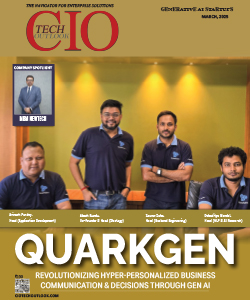Disaster Recovery Life-cycle Automation-Critical Aspect of Business Continuity
Sathya Prasad Rai, Co- Founder & CEO, Sanovi Technologies
 Human induced outage or natural disaster has always been a nightmare for CIOs and IT heads. In the eventuality of a natural or human induced outage, CIOs and IT managers work as per their existing business continuity plans and run-books that define what needs to be done in such emergencies. However, meeting business-set recovery SLA is a challenge when the recovery process is based on run books and manual execution of run-book steps. So, there is a need for Recovery Automation. Complete DR Lifecycle automation gives enterprises the confidence that the recovery process will work, by eliminating operator errors and reducing dependence on experts. Another critical aspect is bringing the people, tasks and documents together by integrating diverse teams spread across regions for faster IT recovery. This can happen through the business continuity command centre for crisis communications, incident management and faster emergency
Human induced outage or natural disaster has always been a nightmare for CIOs and IT heads. In the eventuality of a natural or human induced outage, CIOs and IT managers work as per their existing business continuity plans and run-books that define what needs to be done in such emergencies. However, meeting business-set recovery SLA is a challenge when the recovery process is based on run books and manual execution of run-book steps. So, there is a need for Recovery Automation. Complete DR Lifecycle automation gives enterprises the confidence that the recovery process will work, by eliminating operator errors and reducing dependence on experts. Another critical aspect is bringing the people, tasks and documents together by integrating diverse teams spread across regions for faster IT recovery. This can happen through the business continuity command centre for crisis communications, incident management and faster emergency
response management.
With regards to the event of a disaster at the primary site, outsourced vendors should have a strong workspace recovery, so that they can resume operations immediately from an alternate location.
Right Replication Methodology
It is also true that numerous replication technologies make up today’s application architecture. Heterogeneous platforms and databases cause further confusion regarding the DR strategy to be adopted. To address this issue, IT Managers should choose the right replication technology based on the Business Defined SLAs – Recovery Time Objective and Recovery Point Objective for the application.
Enterprises today are not only concerned about data backup but focus more on recovering the application data and business services soon. There is an increasing focus on getting the business services up and running quickly after an outage. When the external-facing business applications of enterprises are not available, there is a hue and cry; even the regulators start asking questions regarding availability of services. This is more so for Banking, Utilities and Healthcare companies. So, the businesses need to categorize their IT applications into buckets which could be termed as “Mission Critical”, “Business Critical”, “Important” services and so on. Then businesses should define the SLAs in terms of RTOs and RPOs for each category, and implement required Recovery Automation Solutions to meet
the SLAs.
Optimistic DR Market
Due to technology advances and changing customer profiles organizations have to handle unprecedented number of transactions 24 x 7. They cannot afford IT outages and data losses anymore as any failure, even of slightest degree, can put the organization at a great reputational and financial risk. This is why BCPDR market is rapidly expanding. According to a report by Markets and Markets, the DR based cloud market is growing at 55 per cent compound annual growth rate (CAGR) and estimated to grow up to USD Six billion by 2018. The enterprise DR management market is anywhere between USD One billion and USD Two billion.




